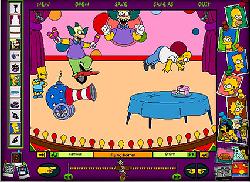Lights . . . camera . . . DOH!
| Mac Minimum System Requirements |
| 68030 33Mhz |
| System 7 |
| 8 MB of RAM |
| 7 MB of Hd space |
| 640 x 480 Display |
| 2x CD-ROM |
So, you think you can handle the cut-throat world of
prime-time cartoon making, do you? You think you can fit into that huge,
over-priced director’s chair, cast, edit, and create your own low budget,
sweat-shop quality, animated feature?… Really?! Well, OK.
(Warning: This is a toy. While batteries or assembly are not required, this
is still a toy. It cannot and should not be in any way be confused to be a
serious attempt at creating a Cartoon Studio of any sort.)
Take 1: The Simpson’s Cartoon Studio provides the amateur filmmaker with the
basic tools necessary to compose your own comedic cartoon catastrophe (Note: puffy director’s pants are NOT included and are sold separately). You
are provided with a basic editing interface upon which you can add twelve
independent objects that will interact in the future feature. These objects
include the background, props, and various animated characters. Objects
can be layered to give the effect of one object being placed in “front” of
another. You also have the use of a sound editor. This allows you to intersperse a soundtrack along with
individual character voice samplings to bring to life the mute motions of
your animated marionettes. You can also view and move through each
individual frame of your cartoon with a trusty Krusty slider and edit out
any bothersome bloopers.
Take 2: Animating characters is a piece of cake (i.e. easy as pie). Each
individual character is provided with his own set of pre-created animations
which can be easily manipulated to provide hours and hours of motion (actual
time dictated by quantity of RAM). The animations are entirely two
dimensional and are presented in the form of cardboard cutouts that are
“stuck” onto the backgrounds. All of the animations come in two directions,
pointing left and pointing right so that all possible dimensions are
comfortably taken care of. The bulk of the animations are dedicated to the
major characters of the series, i.e. Homer and Bart. Lesser characters are
also provided. They include: Marge, Lisa, Nelson, Milhouse, Mr. Smithers,
Mr. Burns, Apu, Chief Wiggum, and so forth.
Take 3: Special-effects are also included in the game’s Arsenal of
Animation(ECHO-ECho-echo-ho-o . . .). These include explosions, laser effects, and a bevy of “The End” banners to successfully conclude
one’s theatrical endeavors. The special effects help to add a little touch
of spice to the productions and are stylistically faithful to the Simpsons
television series.

Cut!!: Now that everything Simpson’s Cartoon Studio has to offer is out in the open, here are the inherent problems
with the product. The editing interface, while creative and intuitive, lacks in
functionality. The feature of cutting and inserting frames is highly limited
allowing one only to cut frames ahead of a certain point in the cartoon.
Nothing can be done with certain segments
in the cartoon that might be better off removed. The way it handles
characters voices limits the user immensely. Limited to only one audio channel, only one character sound bite
can be played at a time, any overlapping of the sound bites would cause one
the previous bite to be completely removed. This is a big problem in the
game because some sound bites include extraneous moments of silence which
cannot be covered over by the following bites. This creates a series of
artificial pauses which greatly takes away from the natural feel of the
cartoons.
The animations are nothing to toot your horn about either.. Firstly there aren’t enough!!
Although Homer, Marge, Lisa and Bart are backed up by an adequate set of
animations, it is the lesser yet equally delightful characters that are
callously ignored. Background wackos like Groundskeeper Willy, Squishy-chef
Apu Nahasapimapetalon (that’s French), Bumblebee Man, and various other
sideshow characters were seriously lacking in their presence. Apu only had
one animation and 7 accompanying soundbites. Not much to work with. Others
such as the Bumbleeman were provided with adequate host of soundbites but
completely lacked animations of any sort. Such casual neglect of these
minor players in a game dedicated to the Simpsons demonstrates a lack of
knowledge and involvement of the show’s mythos on the part of the creators
of the Simpson’s Cartoon Studio.
Perhaps the worst feature about Simpson’s Cartoon Studio is the total isolation of the program from any outside imput. No sounds, music, animations or other user made extras can be added to the
library provided with the Cartoon Studio, thereby seriously hampering one’s
creativity. Also, once you have made a cartoon, you can only play it on the program itself. You can’t save it as an MPEG or Quicktime to show all your friends. So even if, with their limited animations, you make the funniest cartoon in the known universe, no one can see it unless they own this product.
Print: In conclusion, The Simpson’s Cartoon Studio is, in many ways, a major
disappointment to all us Simpson buffs out here in the cyberworld. It lacks
some major features that would have made the product more interesting
and more fun. The way the product operates right not is not only incomplete, but also highly irritating in many ways. This product can only be recommended
to Simpson extremists who want to own every part of the Simpson franchise or
to the few, the patient Simpsonians who can actually forgive the games many
shortcomings and squeeze some ounce of entertainment from the game.
-
Lacks Characters.
-
Restricting Interface.
-
No Export/Import Capabilities.
-
Falls far short of any Simpsons fans' expectations.









